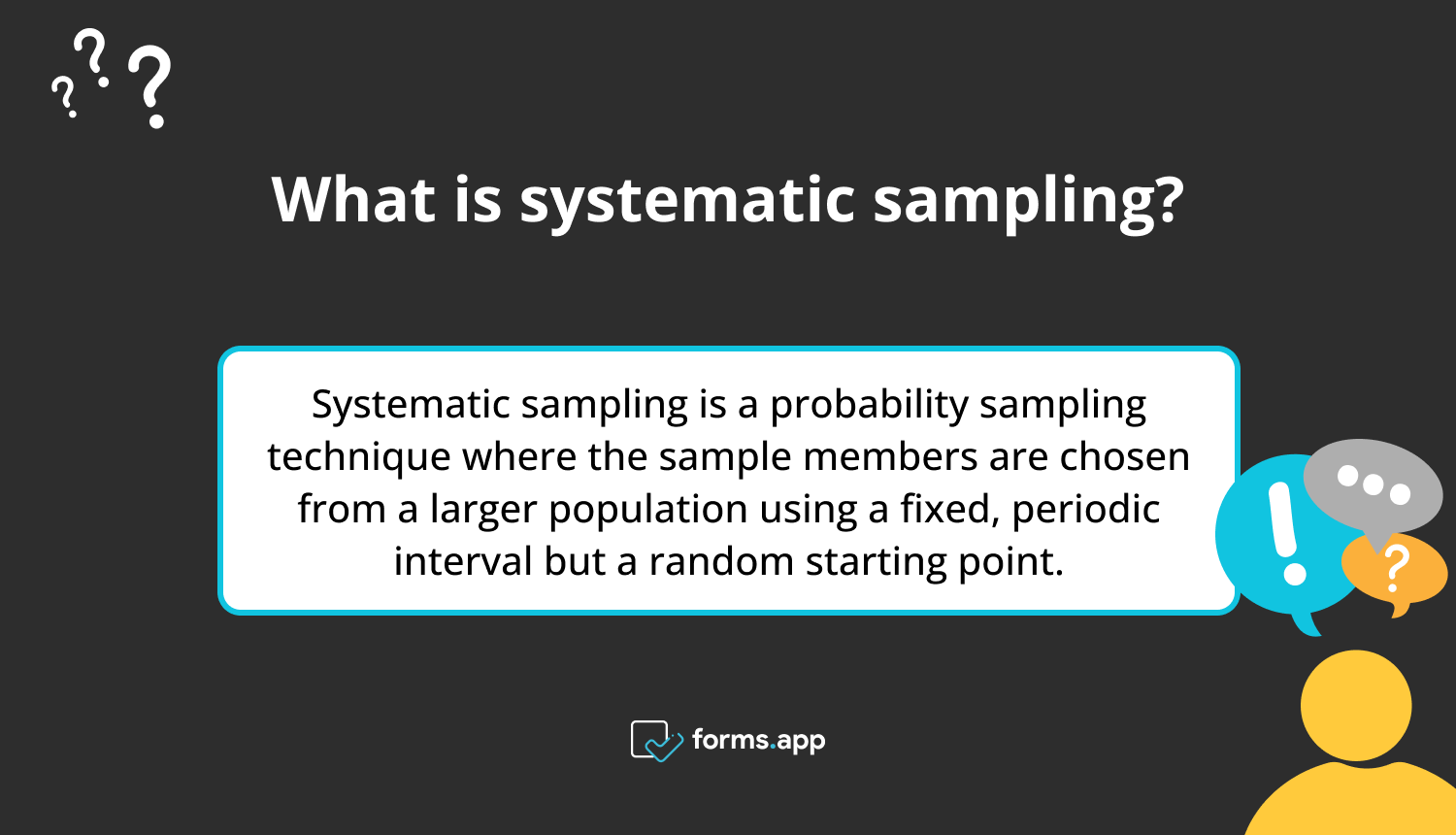There are different sampling methods for your research. Selecting the appropriate sampling technique for your research question is crucial because it can make or break the validity of your findings. If you have a predefined sample range, the systematic sampling method is an appropriate and least time-consuming technique for your research.
Systematic sampling is one of the effective methods you can use to select your sample size in a regular population. Researchers frequently use systematic sampling because it is easier to carry out than simple random sampling, which can be challenging with large people. This article will explain systematic sampling definition, its types, steps, and systematic sampling examples.
The definition of systematic sampling
Systematic sampling is a probability sampling technique in which the sample members are chosen from a larger population using a fixed, periodic interval but a random starting point. This interval called the sampling interval, is calculated by dividing the population by the desired sample size. Each group member is regularly chosen to create a sample in this extended application of probability sampling.
Systematic sampling, when done correctly on a large population of a defined size, can assist researchers, including marketing and sales professionals, in obtaining representative findings on a sizeable group of individuals without getting in touch with every single one.

What is systematic sampling?
Systematic sampling types
Systematic sampling is a statistical technique used to randomly and systematically select a sample from a larger population. This approach is advantageous when the population is sizable, diverse, and challenging to research. There are three methods for creating a systematic sample:
1 - Systematic random sampling: It is a traditional sampling method in which the subject is chosen at predetermined intervals. The researcher can choose an arbitrary starting point between 1 and the sampling interval. Set up a systematic random sample using the producers listed below:
- First, you should determine and set the sampling. Divide the total number of subjects in the population by the number of issues required for the sample to arrive at this calculation.
- Then, choose a random starting point between 1 and the sampling interval.
- Repeat the sampling interval once more to select the following subjects.
2 - Linear systematic sampling: It is possible to select ”n” units as part of the sample with “N” population units using linear systematic sampling, which does not repeat samples at the end. A researcher needs not to randomly select these “n” units; instead, the researcher can use skip logic. Typically, the teams move in a straight line and halt at the edge of a particular population.
The formula for this is sample interval (k)= N/n where N= total population units and n = sample size
Here is the linear systematic sample selection process:
- To arrange the entire population, use a classified sequence
- Choose your sample size (n)
- Calculate the sample interval (k)
- Choose a number randomly between 1 to k
- The following subject will be included in the sample by adding the sampling interval (k) and the randomly chosen number. To have the additional issues in the sample, keep re-executing this process
- Choose the nearest integer to N/n if (k) is not an integer
3 - Circular systematic sampling: A sample starts again at the same point after ending. The best choice is circular sampling. Since you may obtain an N number of samples to work with, assuming the total audience is N. Follow these steps to choose a systematic sampling:
- Calculate the sample interval (k) = N/n
- Start the sampling randomly between 1 to N
- Skip through (k) units to create samples until you select the entire population’s subjects
Steps to conduct a systematic sampling
The process of this sampling method is simple to carry out and understand. The fundamental presumption that the results largely reflect normal populations ensures that the entire population was fairly sampled. Here are some steps to conduct a systematic sampling:
1 - First, create a clearly defined structural audience before beginning to work on the sampling component
2 - Then, determine the ideal size of the sample
3 - After you decide ideal sample size, assign a number to each sample participant
4 - Define the interval of the sample. It will be the standard distance between the subjects
For example, your sample will be 15 if your population size (N) of 7500 is divided by the sample size (n) of 500
Systematic sampling formula for interval (i) = N/n = 7500/500 = 15
5 - Select from the list of 1 in 15 people who meet the criteria
6 - Add the interval to the random number after randomly selecting the starting subject (r) from the sample. The sample should continue to grow until it contains the entire population. To begin, use r, r+i, r+2i, etc.
When to use systematic sampling?

When to use systematic sampling?
The systematic sample will choose individuals from an extensive list of potential participants who are separated from one another by a fixed, regular interval. Currently, a wide range of businesses and organizations use this sampling technique. If you use this sampling method at the right time, it can be a powerful tool. Here are some points when to use systematic sampling:
- Large population: Systematic sampling is much more beneficial when the population is relatively large. However, if you are trying to make deductions about a group of 150 people, polling every 15th person might not result in statistically significant findings, even if these people were given random numbers that appeared unrelated.
- Budget constraints: Systematic sampling is ideal for researchers working within financial restrictions because it is frequently the least expensive way to produce an observably random sample. Therefore large, complete data sets, data sets lacking systematic patterns, and resource-constrained research projects are all the best suited for systematic sampling.
- Systematic sampling without a population list: When you don’t have access to a complete list of the population beforehand, systematic sampling can be used to mimic the randomization of simple random sampling
- Simple implementation: Since systematic sampling relies on predetermined sampling intervals to determine the sample, managing samples with more respondents is made easy for researchers and statisticians. This is because systematic sampling is provided, requiring little time and little money to create samples.
Key points to take away
In conclusion, systematic sampling is a type of sampling technique that involves choosing a smaller group of participants (the sample) from a larger group of participants (the population). Researchers frequently prefer the systematic sampling method because it is simple and less likely to introduce sampling bias into the sample.
Systematic sampling uses regular, fixed intervals to sample a large population. It is a sampling method that is basic, clear-cut, and simple to use, all things being equal. Although this sampling method has some disadvantages, such as stringent prerequisites and clustering problems, it is still well-liked by researchers worldwide.
Sena is a content writer at forms.app. She likes to read and write articles on different topics. Sena also likes to learn about different cultures and travel. She likes to study and learn different languages. Her specialty is linguistics, surveys, survey questions, and sampling methods.



